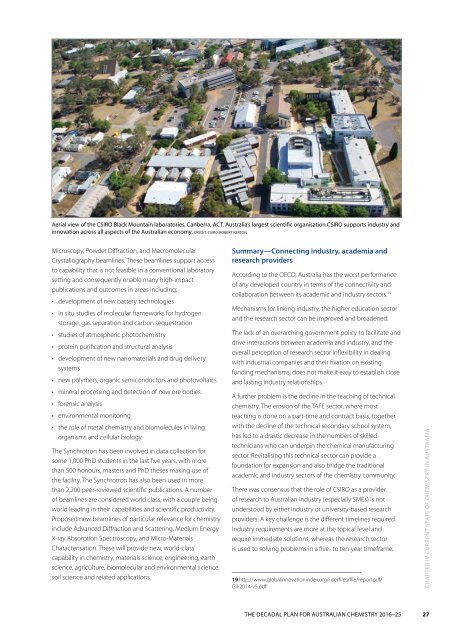Chemistry for a better life
1OiFLmD
1OiFLmD
Create successful ePaper yourself
Turn your PDF publications into a flip-book with our unique Google optimized e-Paper software.
Aerial view of the CSIRO Black Mountain laboratories, Canberra, ACT. Australia’s largest scientific organisation CSIRO supports industry and<br />
innovation across all aspects of the Australian economy. CREDIT: CSIRO/ROBERT KERTON<br />
Microscopy, Powder Diffraction, and Macromolecular<br />
Crystallography beamlines. These beamlines support access<br />
to capability that is not feasible in a conventional laboratory<br />
setting and consequently enable many high-impact<br />
publications and outcomes in areas including:<br />
• development of new battery technologies<br />
• in situ studies of molecular frameworks <strong>for</strong> hydrogen<br />
storage, gas separation and carbon sequestration<br />
• studies of atmospheric photochemistry<br />
• protein purification and structural analysis<br />
• development of new nanomaterials and drug delivery<br />
systems<br />
• new polymers, organic semiconductors and photovoltaics<br />
• mineral processing and detection of new ore bodies<br />
• <strong>for</strong>ensic analysis<br />
• environmental monitoring<br />
• the role of metal chemistry and biomolecules in living<br />
organisms and cellular biology.<br />
The Synchrotron has been involved in data collection <strong>for</strong><br />
some 1,000 PhD students in the last five years, with more<br />
than 500 honours, masters and PhD theses making use of<br />
the facility. The Synchrotron has also been used in more<br />
than 2,200 peer-reviewed scientific publications. A number<br />
of beamlines are considered world class, with a couple being<br />
world leading in their capabilities and scientific productivity.<br />
Proposed new beamlines of particular relevance <strong>for</strong> chemistry<br />
include Advanced Diffraction and Scattering, Medium Energy<br />
X-ray Absorption Spectroscopy, and Micro-Materials<br />
Characterisation. These will provide new, world-class<br />
capability in chemistry, materials science, engineering, earth<br />
science, agriculture, biomolecular and environmental science,<br />
soil science and related applications.<br />
Summary—Connecting industry, academia and<br />
research providers<br />
According to the OECD, Australia has the worst per<strong>for</strong>mance<br />
of any developed country in terms of the connectivity and<br />
collaboration between its academic and industry sectors. 19<br />
Mechanisms <strong>for</strong> linking industry, the higher education sector<br />
and the research sector can be improved and broadened.<br />
The lack of an overarching government policy to facilitate and<br />
drive interactions between academia and industry, and the<br />
overall perception of research sector inflexibility in dealing<br />
with industrial companies and their fixation on existing<br />
funding mechanisms, does not make it easy to establish close<br />
and lasting industry relationships.<br />
A further problem is the decline in the teaching of technical<br />
chemistry. The erosion of the TAFE sector, where most<br />
teaching is done on a part-time and contract basis, together<br />
with the decline of the technical secondary school system,<br />
has led to a drastic decrease in the numbers of skilled<br />
technicians who can underpin the chemical manufacturing<br />
sector. Revitalising this technical sector can provide a<br />
foundation <strong>for</strong> expansion and also bridge the traditional<br />
academic and industry sectors of the chemistry community.<br />
There was consensus that the role of CSIRO as a provider<br />
of research to Australian industry (especially SMEs) is not<br />
understood by either industry or university-based research<br />
providers. A key challenge is the different timelines required.<br />
Industry requirements are more at the topical level and<br />
require immediate solutions, whereas the research sector<br />
is used to solving problems in a five- to ten-year timeframe.<br />
19 http://www.globalinnovationindex.org/userfiles/file/reportpdf/<br />
GII-2014-v5.pdf<br />
Chapter IV Current state of chemistry in Australia<br />
THE DECADAL PLAN FOR AUSTRALIAN CHEMISTRY 2016–25 27


